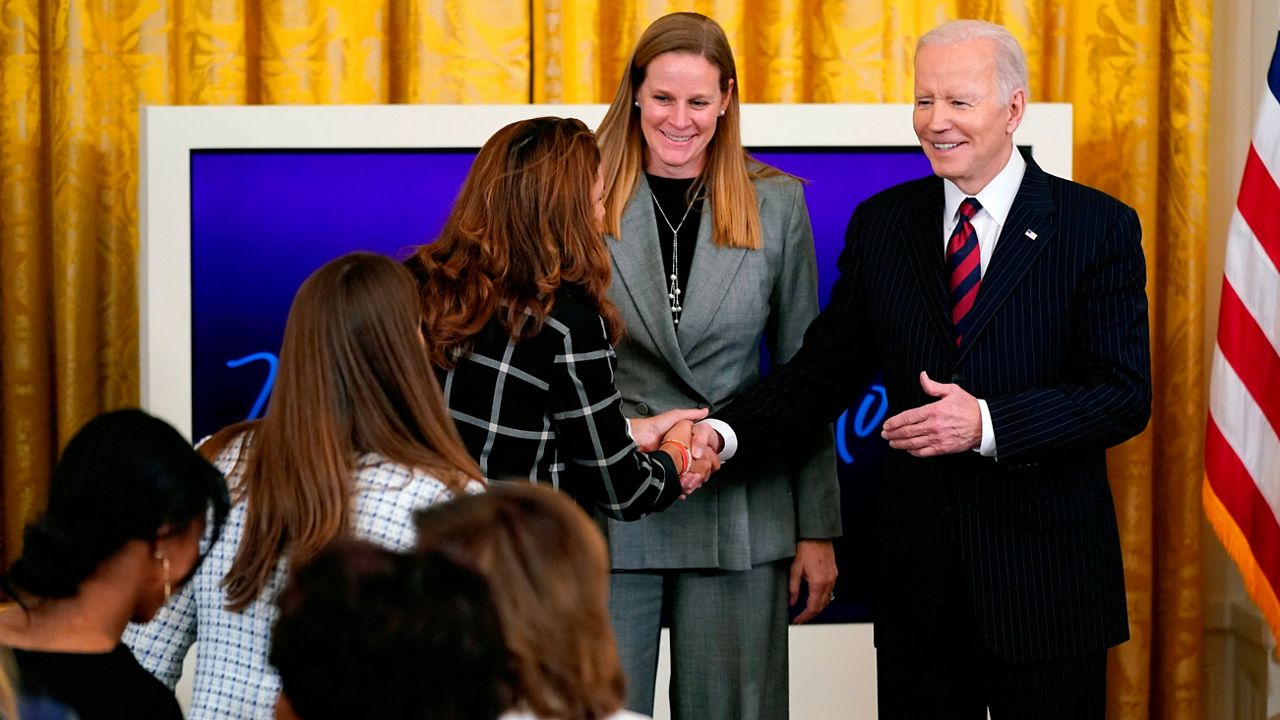The White House marked Equal Pay Day by taking new steps aimed at ending the gender pay gap for federal workers and contractors.
President Joe Biden on Tuesday signed an executive order encouraging the government to ban federal contractors from seeking information about job applicants' prior salary history.
What You Need To Know
- The White House marked Equal Pay Day by taking new steps aimed at ending the gender pay gap for federal workers and contractors
- President Joe Biden on Tuesday signed an executive order that encourages the government to consider banning federal contractors from seeking information about job applicants' prior salary history
- Equal Pay Day is designed to call attention to how much longer women must work to earn what men earned in the previous year
- Data shows that while the pay gap is at its smallest ever, the coronavirus pandemic has altered women's labor force participation
"Earlier today, I signed an executive order to promote efforts to achieve pay equality, pay equity for employees of federal contractors, and it's my hope that this sets an example for all private companies to follow," Biden said.
Also, a new Labor Department directive aims to strengthen federal contractors' obligations to audit payrolls to help guard against pay disparities based on gender, race or ethnicity.
"We're doing so by expanding access to good paying jobs, lower costs for child care and elder care, so women can get back to work and families can have economic security," Biden told a crowd gathered at the White House Tuesday evening.
"Gender equality is not a woman's issue alone. It benefits everybody, that's a fact. It benefits everyone: our society, our economy, and our country," Biden said.
The Office of Personnel Management also is considering a regulation to address the use of prior salary history in hiring and setting compensation for federal workers.
Equal Pay Day is designed to call attention to how much longer women must work to earn what men earned in the previous year.
Data shows that while the pay gap is at its smallest ever, the coronavirus pandemic has altered women's labor force participation so that "what we're seeing is an artificial narrowing," said Jasmine Tucker, director of research at the National Women's Law Center.
For instance, women who remained in the labor force during the pandemic and worked full time often had higher earnings than their counterparts who lost low-paying jobs, indicating that 2020 figures cannot be compared with wage gap data from prior years, Tucker said.
On Tuesday, during an event at the South Court Auditorium, Vice President Kamala Harris pointed out the aspirational nature of celebrating "Equal Pay Day."
“Our economy just has not been working as it should for the women of our nation. Across industries, women are less likely to be hired than equally qualified men. They get paid less and promoted slower for doing similar work,” Harris said. "Women are routinely shut out of good jobs in high-paying industries...in part because our society tells women that some industries are just not for them."
In 2020, the average woman who worked full-time all year earned 83 cents on the dollar compared with her male colleague doing the same work, according to the White House. The gap is even bigger for Black and Native American women and Latinas. Those disparities, Harris noted, lead to the average woman making $400,000 less over a 40-year career than the average man; for indigenous women, and women of color, that loss is closer to $1 million.
Among other issues, the Biden administration wants to combat occupational segregation to get women better access to well-paying jobs, which tend to be male-dominated, according to a senior administration official who previewed the administration's efforts on Monday, speaking on the condition of anonymity.
Last October, the administration issued a national gender strategy to advance women's and girls' full participation in society.
This year, the administration is looking for new ways to combat pay disparities and drawing attention to high-profile efforts to combat the wage gap, such as the U.S. women's national soccer team's $24 million February settlement with U.S. Soccer in a discrimination dispute.
The settlement includes a commitment to equalize pay and bonuses to match the men's team.
"I think we're going to look back on this moment and just think, 'Wow, what an incredible turning point in the history of U.S. Soccer that changed the game and changed the world, really, forever,'" star midfielder Megan Rapinoe said at the time.
Biden, first lady Jill Biden and administration officials marked Equal Pay Day with a Tuesday afternoon event attended by members of the women's soccer team.
"Today I'm honored to be with some of hte world's greatest soccer players, who happen to be women," Biden said. "They've won World Cups, the Olympic gold medal...and after much, much, much too long, equal pay."
Harris was scheduled to attend the afternoon event, but hung back after her husband, Doug Emhoff, tested positive for COVID-19.
"He's feeling very well, I'm told," Biden said during his remarks.
Tucker said there is a long way to go to achieve equal pay — especially after the pandemic. There were in excess of 1.1 million fewer women in the labor force in February 2022 than in February 2020, which means they are neither working nor searching for employment.
"There was a particular shedding among low-paid workers, and what was left was middle- and higher-paid workers who were insulated from the pandemic," Tucker said.
The issue impacts women even later in life. A 2020 Brookings Institution study on women's retirement found Social Security benefits for women are, on average, 80% of those for men.
